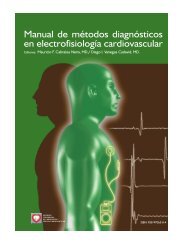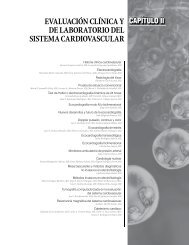GUIAS HIPERTENSION ARTERIAL.indb - Scc
GUIAS HIPERTENSION ARTERIAL.indb - Scc
GUIAS HIPERTENSION ARTERIAL.indb - Scc
You also want an ePaper? Increase the reach of your titles
YUMPU automatically turns print PDFs into web optimized ePapers that Google loves.
Revista Colombiana de Cardiología<br />
Febrero 2007<br />
daño renal y reduce el riesgo de padecer eventos cardio-vasculares,<br />
así mismo se logra una presión arterial<br />
menor de 125/75 mm Hg en enfermedad renal crónica<br />
con proteinuria mayor a 1 gramo. Los medicamentos que<br />
bloquean el sistema renina–angiotensina son superiores<br />
para retrasar la progresión del daño renal. En nefropatía<br />
no diabética los inhibidores de la enzima convertidora<br />
de angiotensina deben ser la terapia de primera línea<br />
en pacientes con enfermedad renal crónica, usados<br />
como terapia individual o como parte de una terapia<br />
combinada hasta lograr obtener cifras adecuadas de<br />
presión arterial.<br />
Sebastián Vélez Peláez<br />
Nota del editor<br />
La enfermedad renal asociada a hipertensión arterial,<br />
es un aspecto fundamental a tener en cuenta<br />
en el tra-tamiento de ésta. El riesgo renal asociado a<br />
hipertensión arterial, se presenta incluso en pacientes<br />
con presión normal alta, quienes tienen doble de riesgo<br />
que los individuos con presión óptima (35). El riesgo<br />
renal tiene mayor asociación con la presión sistólica<br />
que con la diastólica.<br />
A todo paciente hipertenso debe hacérsele una estimación<br />
de la función renal al principio de la evaluación,<br />
y luego periódicamente de acuerdo con su evolución.<br />
La medición de la creatinina sérica sola no es suficiente;<br />
la filtración glomerular debe estimarse siempre, lo cual<br />
puede hacerse empleando las fórmulas de Cockroft<br />
- Gault o MDRD (usualmente no es necesario medirla<br />
directamente) (36-38). Ello es de particular importancia<br />
en pacientes de edad avanzada, en quienes el deterioro<br />
de la función renal puede acompañarse de cifras no muy<br />
elevadas de creatinina sérica. El límite inferior aceptado<br />
como normal es de 60 mL/min (39).<br />
Fórmula de Cockroft-Gault<br />
Filtración glomerular = (140-edad) x peso (kg)/creatinina sérica (mg/dL) x 72<br />
(multiplicar por 0,85 en mujeres)<br />
Fórmula MDRD simplificada<br />
Filtración glomerular (mL/min/1,73 m 2 = 186 x creatinina sérica-1.154 x edad-0,203<br />
(multiplicar por 0,742 en mujeres y por 1,21 en personas de raza negra)<br />
Vol. 13 Suplemento 1<br />
ISSN 0120-5633<br />
Bibliografía<br />
277<br />
1. National Kidney Foundation. K/DOQI Clinical practice guidelines for chronic<br />
kidney disease: evaluation, classification and stratification. Am J Kidney Dis<br />
2002; 39: S1-S266.<br />
2. Bidani A, Griffin K. Long term renal consequences of hypertension for normal<br />
and diseased kidneys. Curr Opin Nephrol 2002; 11: 73-80.<br />
3. Peterson JC, Adler S, Burkart JM, et al. Blood pressure control, proteinuria and<br />
the progression of renal disease. The Modification of Diet in Renal Disease Study.<br />
Ann Intern Med 1995; 123: 754-762.<br />
4. Jafar TH, Schmid CH, Landa M, et al. Angiotensin-converting enzyme inhibitors<br />
and progression of nondiabetic renal disease. A meta-analysis of patient level<br />
data. Ann Intern Med 2001; 135: 73-87.<br />
5. Segura J, Campo C, Gil P, et al. Development of chronic kidney disease and<br />
cardiovascular prognosis in essential hypertensive patients. J Am Soc Nephrol<br />
2004; 15: 1616-1622.<br />
6. Hsu CY. Does non-malignant hypertension cause renal insufficiency? Evidencebased<br />
perspective. Curr Opin Nephrol Hypertens 2002; 11: 267-272.<br />
7. Luke G. Hypertensive nephrosclerosis: pathogenesis and prevalence. Nephrol<br />
Dial Transplant 1999; 14: 2271-2278.<br />
8. Nolan C, Schrier R. The kidney in hypertension. En: Renal and Electrolyte Disorders.<br />
Lippincott Williams & Wilkins; 2003. p. 341-400.<br />
9. Jafar TH, Stark P, Schmid CH, et al. Progression of chronic kidney disease: The<br />
role of blood pressure control, proteinuria, and angiotensin–converting enzyme<br />
inhibition. A patient level meta-analysis. Ann Intern Med 2003; 139: 244-252.<br />
10. Go AS, Chertow GM, Fan D, McCulloch CE, Hsu CY. Chronic kidney disease<br />
and the risks of death, cardiovascular events and hospitalization. N Engl J Med<br />
2004; 351: 1296-1305.<br />
11. Anavekar NS, McMurray JV, Velásquez EJ, et al. Relation between renal dysfunction<br />
and cardiovascular outcomes after myocardial infarction. N Engl J Med 2004;<br />
351: 1285-1295.<br />
12. Sarnark M, Levey A, Schoolwerth AC, et al. American Heart Association Councils<br />
on Kidney in Cardiovascular Disease, High Blood Pressure Research, Clinical<br />
Cardiology, and Epidemiology and Prevention. Kidney Disease as a Risk Factor<br />
for Development of Cardiovascular Disease: a statement from the American Heart<br />
Association Councils on Kidney in Cardiovascular Disease, High Blood Pressure<br />
Research, Clinical Cardiology, and Epidemiology and Prevention. Circulation<br />
2003; 108: 2154-2169.<br />
13. Chobanian AV, Bakris GL, Black HR, et al, and the National High Blood Pressure<br />
Education Program Coordinating Committee. The Seventh Report of the Joint<br />
National Committee on Prevention, Detection, Evaluation, and Treatment of<br />
High Blood Pressure. The JNC 7 report. JAMA 2003; 289: 2560-2572.<br />
14. European Society of Hypertension-European Society of Cardiology Guidelines<br />
Committee. 2003 European Society of Hypertension-European Society of Cardiology<br />
guidelines for the management of arterial hypertension. J Hypertens<br />
2003; 21: 1011-1053.<br />
15. Eknoyan G, Hostetter T, Bakris G, et al. Proteinuria and other markers of chronic<br />
kidney disease: a position statement of the national kidney foundation (NKF)<br />
and the national institute of diabetes and digestive and kidney disease (NIDDK).<br />
Am J Kidney Dis 2003; 42: 617-622.<br />
16. Gaede P, Vedel P, Larsen N, et al. Multifactorial intervention and cardiovascular<br />
disease in patients with type 2 diabetes. N Engl J Med 2003; 348: 383-393.<br />
17. Maschio G, Alberti D, Janin G et al. Effect of the angiotensin-enzyme inhibitor<br />
benazepril on the progression of chronic renal insufficiency. N Engl J Med 1996;<br />
334: 939-945.<br />
18. The GISEN group (Gruppo Italiano di Studi Epidemiologici in Nefrologia).<br />
Randomised placebo-controlled trial of effect of ramipril on decline in glomerular<br />
filtration rate and risk of terminal renal failure in proteinuric, non-diabetic<br />
nephropathy. Lancet 1997; 349: 1857-1863.<br />
19. Ruggenenti P, Perna A, Gherardi G, et al. Renal function and requirement for<br />
dyalisis in chronic nephropathy patients on long-term ramipril. REIN follow-up<br />
trial. Gruppo Italiano di studi epidemiologici in nefrología (GISEN). Ramipril<br />
Efficay in Nephropathy. Lancet 1998; 352: 1252-1256.<br />
20. Ruggenenti P, Perna A, Benini R, et al. In chronic nephropathies prolonged ACE<br />
inhibition can induce remission: dynamics of time dependent changes in GRF.<br />
Investigators of the GISEN group. Gruppo Italiano di studi epidemiologici in<br />
nefrología. J Am Soc Nephrology 1999; 10: 997-1006.




